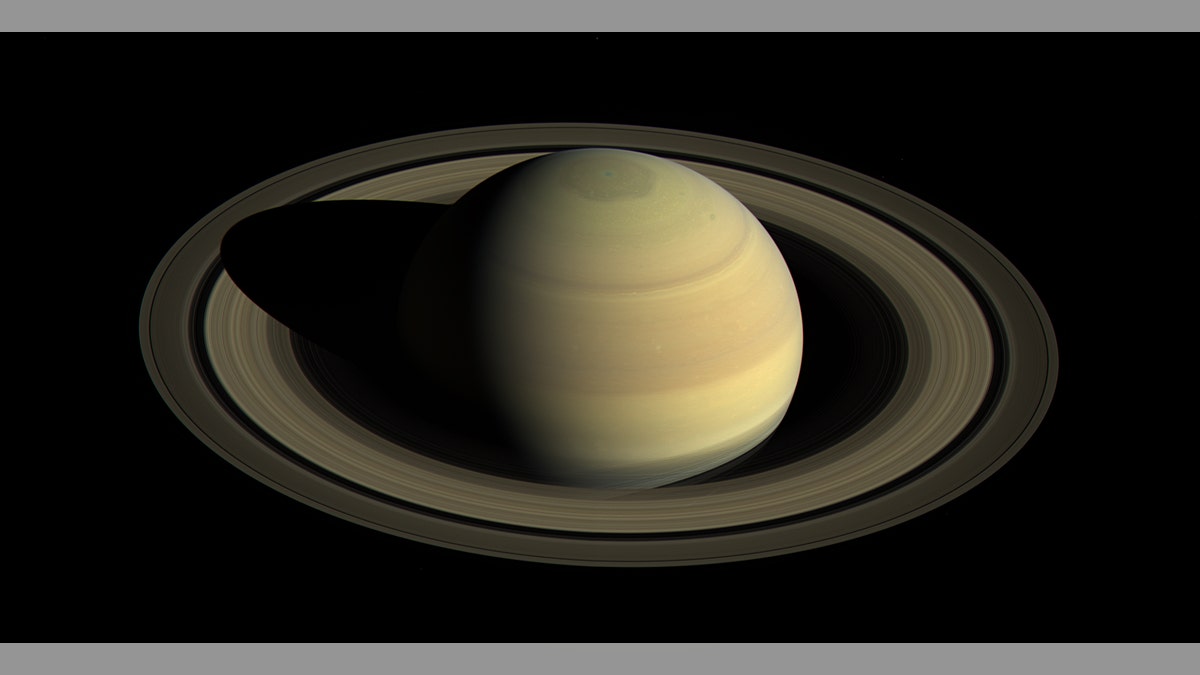
Saturn. (NASA/JPL-Caltech/Space Science Institute)
While the dinosaurs roamed the Earth, Saturn’s rings may have been forming in space. So says a new study based on a large amount of almost–forgotten data from NASA’s Cassini mission, which has been observing the planet since 2004.
Saturn’s rings are made up of primarily ice particles that measure anywhere from a few inches up to several yards in size. The rings are believed to have been pure ice water when they were formed (even today they’re mostly ice), but over time they were continuously hit with micrometeoroids: pieces of ice and rock thought to be leftover material from the formation of the solar system. A good bit of this rocky “pollution” has collected on the ice over the years, and the proportion of accumulated meteoroids can be used to narrow down something that has long eluded scientists—the age of Saturn’s rings.
PLUTO COULD HARBOR A SUBTERRANEAN ICY OCEAN
“Due to Saturn’s rings’ huge surface area, they are especially susceptible to bombardment from these micrometeoroids,” study author Zhimeng Zhang, a graduate student at Cornell University, told Foxnews.com. “So, if we know the flux of these micrometeoroids (which was also measured by Cassini), how much is actually hitting the rings, and if we know how much non-icy material there is in the rings, then we can use it to put tight constraints on ring age.”
Finding out the level of “pollution” on the ring ice particles was no easy task. First, Zhang had to analyze decade-old data collected by instruments built to study the surface of Titan, one of Saturn moons. In addition to the sheer quantity of information, Zhang believes the data was also left unanalyzed for years due to its complexity.
STRANGE FEATURE ON MARS IS A GOOD PLACE TO LOOK FOR LIFE, STUDY SAYS
“I think the main reason that led to the data sitting around untouched for a while is that the calibration process, which involves a crucial de-convolution process, is very complicated,” she said. “I have spent almost three years working on this data.”
Of particular interest to Zhang was data collected by the Cassini Titan Radar Mapper. Since the ice is opaque to many wavelengths of light, the particles are able to conceal the amount of rock clinging to them. This is where the Radar Mapper comes in handy. Operating at a wavelength in the microwave end of the electromagnetic spectrum that makes it possible to pierce the ice, the Mapper examines the entire ring composition, and not just the surface.
Zhang’s focus was on Saturn’s C ring. Because of its relative low mass, this ring had collected the most micrometeoroid pollution, making it an ideal candidate for study.
MOON HAD A DRAMATIC, EXPLOSIVE HISTORY, STUDY SAYS
After analyzing this data, Zhang was able to build physical models and simulate how light scatters off of and between particles in the rings. The results showed that most regions in the C ring contain about 1-2% silicates.
“These results are consistent with an initially nearly pure-ice ring system that has been continuously contaminated by in-falling micrometeoroids over as much as 100 million years, using the accepted values we know for the micrometeoroid flux,” she said.
More surprisingly, Zhang and her team also found an enhanced abundance of non-icy material concentrated in the middle C ring, indicating that Centaurs—rocky objects that orbit between Jupiter and Neptune and can sometimes measure up to 160 miles or more in diameter— have had at least one encounter with the rings.
“We proposed that in addition to the C ring being continuously polluted by micrometeoroid bombardment over their history, the middle C ring was further contaminated by an incoming Centaur which was torn apart by Saturn’s tides and deposited in the rings,” Zhang explained. “The Centaur was likely captured and integrated into the rings perhaps as recently as little as 10-20 million years ago.”
15 MONTHS LATER, NASA'S PLUTO PROBE SENDS BACK LAST BIT OF DATA
Her end results indicate that Saturn’s C ring is somewhere between a mere 15 and 100 million years old— a big difference between the 3.8 billion-year age range previously believed. This would mean that the rings were forming around the tail end of the dinosaurs’ 175 million–year run here on Earth.
Zhang and her team plan on studying the rings more, and are looking forward to the next wave of Cassini mission data in the hope of conclusively proving their findings. The mission ends in 2017, when the Cassini spacecraft flies into Saturn.
“Next year, during the grand finale of Cassini mission in 2017, we will obtain more passive and active radar observations on the rings at unprecedented resolution and at a variety of different geometries,” she said. “We are really excited about these observations, because they will give us very valuable and further insights on the rings’ properties, dynamics and origins, but—especially for me— to further prove what we have proposed in our paper to be correct.”
The study can be found in the January 2017 edition of the science journal Icarus.
